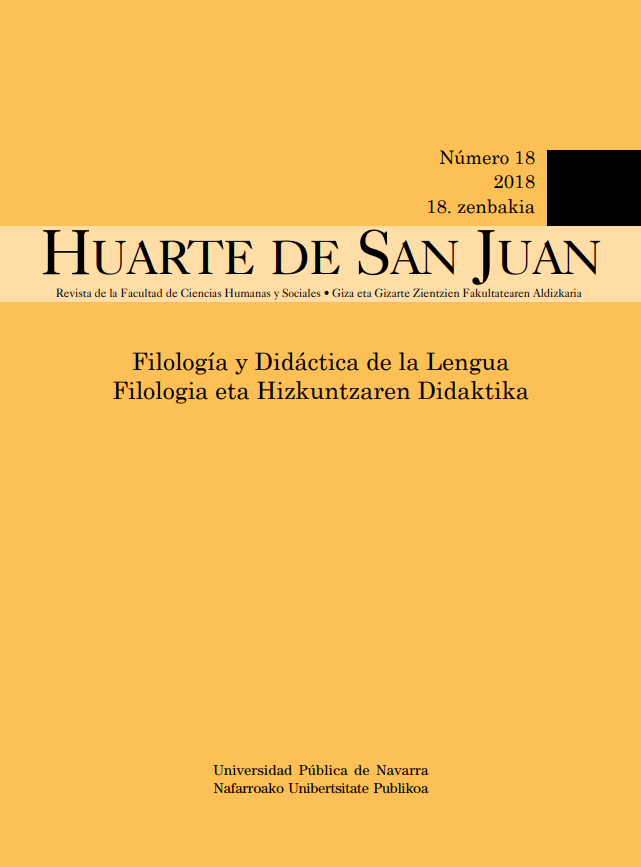Teachers’ beliefs about oral corrective feedback: a comparison of secondary and adult education
Palabras clave:
Feedback oral, creencias, actitudes, inglés como lengua extranjeraResumen
Aunque existe un gran número de estudios que demuestran la eficacia del feedback oral para la adquisición de una segunda lengua, no está claro hasta qué punto los profesores creen que el feedback es útil. Algunos estudios han mostrado que los alumnos generalmente quieren que se les corrija mucho más de lo que sus profesores estiman necesario. Sin embargo, otros aspectos relacionados con el feedback oral, como por ejemplo los tipos de feedback y el momento adecuado de dar feedback, han recibido muy poca atención en dichos estudios. Por eso, el presente estudio compara las creencias de dos grupos de profesores de inglés como lengua extranjera sobre: cuándo corregir, cuánto corregir y qué tipos de errores corregir. A pesar de las diferencias de contexto, los dos grupos estaban de acuerdo en que el feedback es importante, pero que demasiadas correcciones pueden interferir con el desarrollo de la fluidez y la confianza de los alumnos. La mayoría de los profesores también preferían tipos más implícitos de feedback. Estos resultados indican que existe la necesidad de incrementar la formación del profesorado en el tema del feedback oral.
Descargas
Citas
Baily, K.M. (1992). The processes of innovation in language teacher development: What, why and how teachers change. In J. Flowerdew, M. Brock & S. Hsia (eds.), Perspectives on second language teacher education (pp. 253-282). Hong Kong: City Polytechnic of Hong Kong.
Basturkmen, H., Loewen, S., & Ellis, R. (2004). Teachers’ stated beliefs about incidental focus on form and their classroom practices. Applied Linguistics, 25(2), 243-272. doi: Https://doi.org/10.1093/applin/25.2.243
Bell, T. R. (2005). Behaviors and attitudes of effective foreign language teachers: Results of a questionnaire study. Foreign Language Annals, 38(2), 259–270. doi: https://doi.org/10.1111/j.1944-9720.2005.tb02490.x
Borg, S. (2003). Teacher cognition in language teaching: A review of research on what language teachers think, know, believe, and do. Language Teaching, 36(2), 81-109. doi: https://doi.org/10.1017/S0261444803001903
Brown, J.D. (1988). Understanding research in second language learning: A teacher’s guide to statistics and research design. Cambridge, New York: Cambridge University Press.
Buehl, M. M., & Beck, J. S. (2015). The relationship between teachers’ beliefs andteachers’practices. In H. Fives & M. G. Gill (eds.), International handbook of research on teachers’beliefs (pp. 66-84). New York, NY: Routledge.
Cathcart, R., & Olsen, J. (1976). Teachers’ and students’ preferences for correction of classroom conversation errors. In J. Fanselow & R. Crymes (eds.), On TESOL ‘76 (pp. 41-53). Washington, DC: TESOL.
Doughty, C., & Varela, E. (1998). Communicative focus on form. In C. Doughty & J.
Williams (eds.), Focus on form in classroom second language acquisition (pp. 114-138). New York: Cambridge University Press.
Ellis, R., & Sheen, Y. (2006). Reexamining the role of recasts in second language acquisition. Studies in Second Language Acquisition, 28, 575-600. doi: https://doi.org/10.1017/S027226310606027X.
Golombek, P. R. (1998). A study of language teachers’ personal practical knowledge. TESOL Quarterly, 32(2), 447-464.
Harmer, J. (2006). The practice of English language teaching. (3rd ed.). London: Longman.
Hatch, E., & Lazaraton, A. (1991). The research manual: Design and statistics for applied linguistics. Boston: Heinle & Heinle.
Havranek, G. (2002). When is corrective feedback most likely to succeed? International Journal of Educational Research, 37, 255-270. doi: https://doi.org/10.1016/S0883-0355(03)00004-1.
Jean, G., & Simard, D. (2011). Grammar teaching and learning in L2: Necessary, but boring? Foreign Language Annals, 44(3), 467-494. doi: https://doi.org/10.1111/j.1944-9720.2011.01143.x.
Leeman, J. (2003). Recasts and L2 development: Beyond negative evidence. Studies in Second Language Acquisition, 25(1), 37-63.
Long, M. (1996). The role of the linguistic environment in second langauge acquisition. In W. Ritchie & T. Bhatia (eds.), Handbook of second langauge acquisition (pp.413-468). San Diego: Academic Press.
Kormos, J., & Czisér, K. (2008). Age-related differences in the motivation of learning English as a foreign language : Attitudes , selves , and motivated learning behavior. Language Learning, 58(2), 327-355.
Krashen, S.D. (1982). Principles and practice in second language acquisition. Oxford: Pergamon Press.
Krippendorf, K. (2004). Content analysis. An introduction to its methodology. Thousand Oaks, London, New Delhi: Sage Publications.
Larson-Hall, J. (2010). A guide to doing statistics in second language research using SPSS. New York, London: Routledge.
Lasagabaster, D., & Sierra, J. M. (2005). Error correction: Students’ versus teachers’ perceptions. Language Awareness, 14, 112-127. doi: https://doi.org/10.1080/09658410508668828.
Li, S. (2010). The effectiveness of corrective feedback in SLA: A meta-analysis. Language Learning, 60(2), 309-365. doi: https://doi.org/10.1111/j.1467-9922.2010.00561.x.
Lochtman, K. (2002). Oral corrective feedback in the foreign language classroom: How it affects interaction in analytic foreign language teaching. International Journal of Educational
Research, 37, 271-283. doi: https://doi.org/10.1016/S0883-0355(03)00005-3.
Loewen, S., & Philp, J. (2006). Recasts in the adult English L2 classroom: Characteristics, explicitness, and effectiveness. Modern Language Journal, 90(4), 536-556. doi: https://doi.org/10.1111/j.1540-4781.2006.00465.x.
Lyster, R., & Ranta, L. (1997). Corrective feedback and learner uptake: Negotiation of form in communicative classrooms. Studies in Second Language Acquisition, 19, 37-66. doi: Https://doi.org/10.1017/S0272263197001034.
Lyster, R., & Saito, K. (2010). Oral feedback in classroom SLA: A meta-analysis. Studies in Second Language Acquisition, 32, 265-302. doi: https://doi.org/10.1017/S0272263109990520.
Lyster, R., Saito, K., & Sato, M. (2013). Oral corrective feedback in second language classrooms. Language Teaching, 46, 1-40. doi: https://doi.org/10.1017/S0261444812000365.
Mackey, A., & Goo, J. (2007). Interaction research in SLA: A meta-analysis and research synthesis. In A. Mackey (ed.), Conversational interaction and second language acquisition: a collection of empirical studies (pp. 407-453). New York: Oxford University Press.
McDonough, K., & Mackey, A. (2006). Responses to recasts: Repetition, primed production, and linguistic development. Language Learning, 56(4), 693-720.
Panova, I., & Lyster, R. (2002). Patterns of corrective feedback and uptake in an adult ESL classroom. TESOL Quarterly, 36(4), 573-595. doi: https://doi.org/10.2307/3588241.
Rahimi, M., & Zhang, L. J. (2015). Exploring non-native English-speaking teachers’ cognitions about corrective feedback in teaching English oral communication. System, 55, 111–122. doi: https://doi.org/10.1016/j.system.2015.09.006.
Roothooft, H. & Breeze, R. (2016). A comparison of EFL teachers’ and students’ attitudes to oral corrective feedback. Language Awareness, 25(4), 318-335. https://doi.org/10.1080/09658416.2016.1235580.
Russell, J. & Spada, N. (2006). The effectiveness of corrective feedback for the acquisition of L2 grammar. A meta-analysis of the research. In J. Norris & L. Ortega (eds.), Synthesizing research on language learning and teaching (pp. 133-164). Amsterdam: Benjamins.
Schulz, R. A. (2001). Cultural differences in student and teacher perceptions concerning the role of grammar instruction and corrective feedback: USA-Colombia. Modern Language Journal, 85(2), 244-258. doi: https://doi.org/10.1111/0026-7902.00107.
Sheen, Y. (2004). Corrective feedback and learner uptake in communicative classrooms across instructional settings. Language Teaching Research, 8(3), 263-300. doi: https://doi.org/10.1191/1362168804lr146oa.
Sheen, Y. (2007). The effects of corrective feedback, language aptitude, and learner attitudeson the acquisition of English articles. In A. Mackey (ed.), Conversational interaction in second language acquistion: A collection of empirical studies (pp.301-322). Oxford: Oxford University Press.
Truscott, J. (1999). What’s wrong with oral grammar correction. Canadian Modern Language Review, 55, 437-455. doi: https://doi.org/10.3138/cmlr.55.4.457.
Williams, J. (2005). Form-focused instruction. In E. Hinkel (ed.), Handbook of research in second language teaching and learning (pp. 671-691). Mahwah (New Jersey), London: Lawrence Erlbaum Associates.
Yilmaz, Y. (2012). The relative effects of explicit correction and recasts on two target structures via two communication modes. Language Learning, 62(4), 1134-1169. doi: https://doi.org/10.1111/j.1467-9922.2012.00726.x.
Yoshida, R. (2010). How do teachers and learners perceive corrective feedback in the Japanese language classroom? Modern Language Journal, 94(2), 293-314. doi: https://doi.org/10.1111/j.1540-4781.2010.01022.x.
Zacharias, N. T. (2012). Qualitative research methods for second language education: A coursebook. Cambridge: Cambridge Scholars Publishing.
Zhang, L. J., & Rahimi, M. (2014). EFL learners’ anxiety level and their beliefs about corrective feedback in oral communication classes. System, 42(1), 429–439. doi: https://doi.org/10.1016/j.system.2014.01.01.
Descargas
Publicado
Cómo citar
Número
Sección
Licencia
Todos los artículos son publicados bajo una licencia de uso y distribución Creative Commons (BY-NC-ND 4.0). A cada artículo se le asignará un identificador DOI.
Los autores conservan los derechos de autor y conceden a la revista el derecho de la primera publicación. Los autores podrán establecer acuerdos adicionales para la distribución no exclusiva de la versión de la obra publicada en la revista (por ejemplo, situarlo en un repositorio institucional), con un reconocimiento de su publicación inicial en esta revista. Los trabajos podrán subirse a repositorios institucionales inmediatamente tras la publicación de la revista.
Asimismo, se permite y se anima a los autores a difundir sus trabajos electrónicamente (por ejemplo, en repositorios institucionales, redes sociales académicas o en su propio sitio web).







